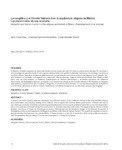Mostrar o rexistro simple do ítem
Lo neogótico y el Concilio Vaticano II en la arquitectura religiosa de México: los reacomodos de una anomalía
| dc.contributor.author | Checa Artasu, Martí | |
| dc.date.accessioned | 2019-05-30T11:43:40Z | |
| dc.date.available | 2019-05-30T11:43:40Z | |
| dc.date.issued | 2005 | |
| dc.identifier.citation | Checa-Artasu, M. (2017). Lo neogótico y el Concilio Vaticano II en la arquitectura religiosa de México. Actas De Arquitectura Religiosa Contemporánea, 4, 174-183. https://doi.org/10.17979/aarc.2015.4.0.5131 | es_ES |
| dc.identifier.issn | 2340-5503 | |
| dc.identifier.uri | http://hdl.handle.net/2183/23087 | |
| dc.description.abstract | [Resumen] En México, el estilo neogótico se desarrolla desde el tercer cuarto del siglo XIX hasta el primer tercio del siglo XX, asociado a una estrategia de reposicionamiento de la Iglesia Católica frente a los gobiernos liberales mexicanos. Sin embargo, los diversos conflictos bélicos, la política anticlerical gubernamental y los problemas económicos hicieron que algunos de los grandes templos iniciados en ese estilo, prolongasen su construcción durante décadas, llegando hasta la actualidad. Este trabajo analiza cómo dos de esos templos, el Santuario Guadalupano en Zamora (Michoacán) y el Templo Expiatorio del Santísimo Sacramento, de Guadalajara (Jalisco), se adaptan a los lineamientos litúrgicos del Concilio Vaticano II. El resultado es una paradoja estética y arquitectónica que convierte lo neogótico, en el exterior de los templos, en una envoltura repleta de simbolismos y en el interior del templo asume los nuevos lineamientos conciliares encajados en los elementos propios del neogótico. | es_ES |
| dc.description.abstract | [Abstract] In Mexico, the Gothic Revival style was developed from the third quarter of the nineteenth century to the early twentieth century, associated with a repositioning strategy of the Catholic Church against the Mexican liberal governments. However, the various wars (Mexican revolution, Cristiada), anticlerical government policies and economic problems made that some of the largest temples in that style was continued slowly their construction for decades, reaching it until today. This paper analyses like two of these temples, the Shrine of Virgen de Guadalupe in Zamora (Michoacán) and the Expiatory Temple of the Blessed Sacrament in Guadalajara (Jalisco) were adapted to the liturgical guidelines of the Second Vatican Council. The result is an aesthetic and architectural paradox that becomes the outside Gothic of these temples in a box full of symbolism while inside of the temple assumes the guidelines Second Vatican Council, but embedded in a Gothic environment | es_ES |
| dc.language.iso | spa | es_ES |
| dc.publisher | Universidade da Coruña | es_ES |
| dc.relation.uri | https://doi.org/10.17979/aarc.2015.4.0.5131 | es_ES |
| dc.rights | Atribución-NoComercial 4.0 España | es_ES |
| dc.rights.uri | http://creativecommons.org/licenses/by-nc/3.0/es/ | * |
| dc.subject | Neogótico | es_ES |
| dc.subject | Concilio Vaticano II | es_ES |
| dc.subject | México | es_ES |
| dc.subject | Arquitectura religiosa | es_ES |
| dc.subject | Adaptación | es_ES |
| dc.subject | Neogothic revival | es_ES |
| dc.subject | Second Vatican Council | es_ES |
| dc.subject | Mexico | es_ES |
| dc.subject | Sacred architecture | es_ES |
| dc.subject | Adaptation | es_ES |
| dc.title | Lo neogótico y el Concilio Vaticano II en la arquitectura religiosa de México: los reacomodos de una anomalía | es_ES |
| dc.title.alternative | Neogothic and Vatican Council II in the religious architecture of Mexico: Rearrangements of an anomaly | es_ES |
| dc.type | info:eu-repo/semantics/article | es_ES |
| dc.rights.access | info:eu-repo/semantics/openAccess | es_ES |
| UDC.journalTitle | Actas de Arquitectura Religiosa Contemporánea | es_ES |
| UDC.volume | 4 | es_ES |
| UDC.startPage | 174 | es_ES |
| UDC.endPage | 183 | es_ES |






